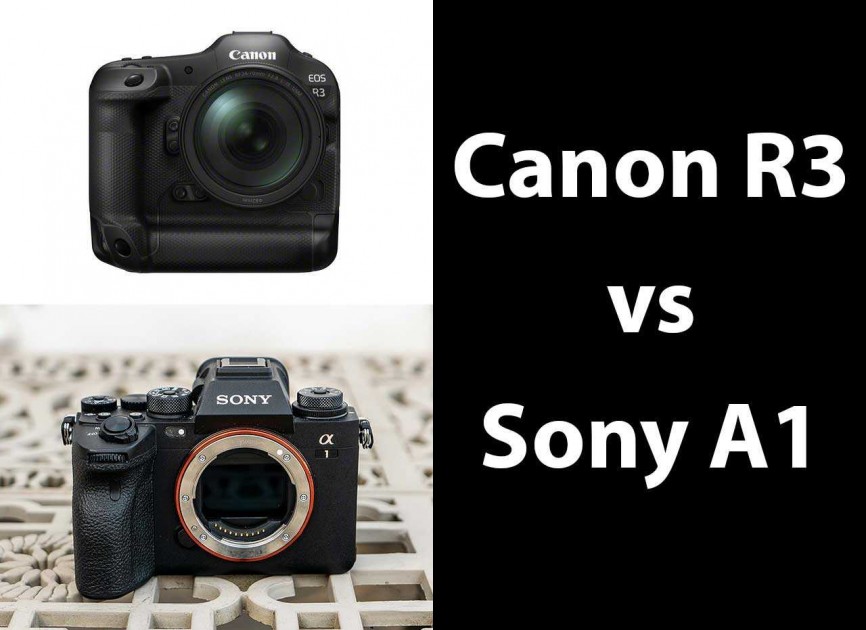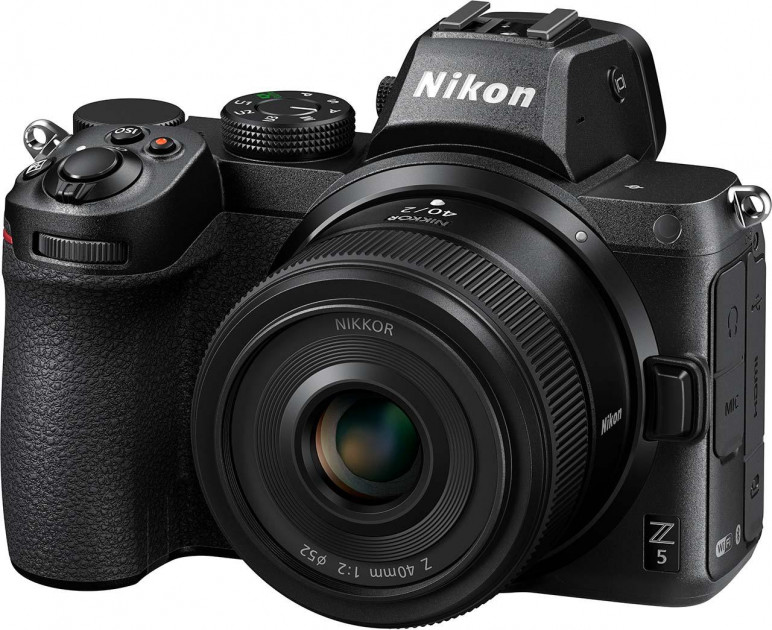The EOS R5 has proved to be a very successful camera for Canon since its launch in early 2020, leading the way in full-frame camera sales in Japan and helping to keep Canon profitable during a very trying year.
With the recent hotly-anticipated launch of the Sony Alpha 1 and the recent announcement of the Nikon Z9, however, Canon have lacked a similarly specced flagship model – until now, that is.
So how does the new EOS R3 differ from the R5, and which of these 35mm full-frame sensor mirrorless cameras is the right one for you?
We’re bringing you this in-depth Canon R3 vs Canon R5 head-to-head comparison to help you choose between them.
Sensor
The Canon R5 has a 45 megapixel sensor, while the EOS R3 has a much more modest 24 megapixel resolution.
What gives the EOS R3 a potentially much bigger advantage is the type of sensor that each camera has. The R5 has a standard CMOS sensor, whereas the R3 is the very first EOS camera to use a Stacked, Back-Side Illuminated (BSI) CMOS sensor (just like the Sony Alpha 1), which potentially translates into better low-light performance at like-for-like ISO speeds.
Canon are also at pains to point out they the new sensor in the R3 has been developed by Canon, and not by the market leader in sensors, Sony.
Processor
The Canon R3 uses exactly the same Digic X image processor as the R5, R6 and EOS-1D X Mark III cameras, which combined with the new stacked BSI sensor allows the R3 to shoot at even faster speeds for both stills and video.
ISO Speed
The native sensitivity range of the Canon R5 is ISO 160 to ISO 51,200, which can be expanded to ISO 50 to ISO 102,400.
The ISO range of the Canon R3 ISO 100 to ISO 102,400, which can be expanded to ISO 50 to ISO 204,800, so slightly greater than the EOS R5.
Autofocus
The Canon R5 employs the Dual Pixel CMOS AF system with a whopping 5,940 individual phase detection points that cover the frame up to 100% vertically and horizontally using the Auto AF area selection.
The new Canon R3 has a “next generation” version of Dual Pixel CMOS AF which tracks and focuses on the eyes, heads and bodies of fast moving subjects better than any other EOS camera.
The R3 also has a brand new vehicle tracking mode, which allows you to expertly track motorbikes, open cockpit Formula cars as well as GT and rally cars, and even has the ability to prioritise the vehicle or the driver’s helmet!
Eye Control Function
Perhaps even more excitingly, the Canon R3 allows you to select and move the AF point with the look of your eye using the electronic viewfinder!
The EOS R3, and indeed no other camera in history, allows you to focus on a subject simply by looking at it through the viewfinder – except for three of Canon’s film SLR cameras, that is.
The EOS 3, 5 and 50 all had an eye-controlled autofocus system where you could calibrate the camera to your eye and then select a particular AF point simply by looking at it. The EOS 5 and 50 only had 3 AF points, so it worked pretty reliably, whereas the EOS 3 had 45 AF points which made the system more hit and miss.
Now the new Canon EOS R3 is attempting to pull off the same trick a few decades later, but in a more sophisticated, more accurate way that’s suitable for the most demanding professional users, billing it as “an AF control system ready for the 21st Century”.
Burst Shooting
The R3 ushers in a “a new era of high speed performance for professionals”, at least according to Canon anyway.
The Canon R5 can capture images at up to 20fps with the electronic shutter or 12fps with the mechanical shutter for 170 JPEG frames, 83 RAW or 130 Compressed C-RAW files.
If you want even faster burst shooting, though, the Canon R3 takes things to another level by being able to shoot at 30fps with the electronic shutter with full AF/AE tracking and minimal image distortion for 540 JPEG or 150 RAW images.
Weather Resistance
The Canon R3 offers the same level of durability and dust and moisture resistant weather-proofing as the flagship EOS-1D X Mark III DSLR camera, which shares the same robust, weather-sealed construction of its predecessor.
The EOS R5 also has excellent weather-sealing that is similar to the Canon EOS 6D Mark II’s protection, so not on the same level as the EOS-1D X Mark III and by association the new EOS R3.
Integrated Grip
The Canon R3 has the same integrated grip with duplicated vertical controls that EOS-1D series users have enjoyed for many years.
Whilst pro shooters will mostly be delighted, some people may find the extra bulk and the lack of flexibility more off-putting.
Fitting the optional BG-R10 battery grip to the R5 achieves much the same thing as having an integrated grip, extending battery life and providing vertical controls whilst maintaining the same level of resistance to dust and moisture, but with the option of removing it if required.
IBIS
The Canon R5 has a pretty incredible stabilisation system, It features 5-axis in-body image stabilisation (IBIS) which provides up to 8-stops of IS when using the camera with certain compatible lenses.
The new R3 offers the same IBIS system as the R5 – its 5-axis In-Body Image Stabilizer can also combine with the optical Image Stabilizer in selected RF lenses to offer industry-leading performance worth up to 8-stops.
Viewfinder
The Canon R5 has a very impressive 5.76M-dot OLED electronic viewfinder with 0.76x magnification and a fast 120fps refresh rate.
Other than the eye-control AF feature, the R3’s viewfinder is exactly the same as the R5’s.
LCD Screen
The Canon EOS R5 has a familiar 3.2-inch LCD panel with 2.1 million dots of resolution, unchanged since its debut on the EOS R camera.
It’s a fully articulating screen that can be flipped out to the side, rotated to the front, and folded against the back of the camera to help protect it.
Surprisingly for such a high-end camera, the EOS R3 also has a versatile vari-angle touch screen which provides greater flexibility of shooting angles thanks to its ability to tilt and rotate into a range of positions, unlike the fixed screen on the EOS-1D X III DSLR camera.
But it’s much higher-resolution than the R5’s screen – 4.1-million dots to be exact – a very welcome upgrade.
Video
The R5 has a headline-grabbing 8K video mode, which along with the Sony A1 makes it one of the only two digital interchangeable lens cameras to offer this feature at present.
The Canon EOS R5 offers 8K internal video recording up to 30p (non-cropped) in 4:2:2 10-bit Canon Log (H.265) or 4:2:2 10-bit HDR PQ (H.265), in addition to 4K video at up to 120p.
When shooting 8K/30p and 4K/60p, the EOS R5 can record for up to 20 minutes before it overheats.
The Canon EOS R3 “only” offers 6K/60p recording due to the 24 megapixel sensor that it uses, in addition to 4K video at up to 120p.
We also hope that the larger body and the negative feedback that Canon have received about the R5 means that the new R3 doesn’t suffer from over-heating in the same way that the R5 did.
And that certainly seems to be the case, as Canon are promising that the R3 can record up to six hours of regular video or 1.5 hours at high 119.88/100p frame rates – great news given all the negative feedback that the R5 received.
Memory Cards
As you would expect from a professional camera, both the EOS R5 and the 1D X III have dual memory card slots, but whereas the R5 has one slot for high-speed UHS-II type SD cards and the other for ultrafast CFexpress cards, the 1D X has two CFexpress slots.
The Canon R3 has one UHS-II SD card slot and one ultra-high speed CFexpress slot, so it follows the lead of the R5 rather than the EOS-1D X Mark III, which has two CFexpress slots.
Battery Life
The Canon R5 uses the LP-E6NH battery which offers a lifespan of 470 shots when using the electronic viewfinder and 490 shots when using the LCD monitor.
The EOS-1D X III differs by using the LP-E19 battery which is CIPA rated to 2850 shots with the optical viewfinder and 610 shots with Live View.
The EOS R3 uses the LP-E19 series battery from the EOS-1D X III rather than the LP-E6NH series that the EOS R5 uses, which provides up to 620 shots when using the viewfinder and 860 shots when using the LCD monitor.
Mobile File Transfer App
Canon are also introducing a new Mobile File Transfer smartphone app to transfer images and speed up workflow whilst on the move using mobile network services rather than wired LAN equipment. It will initially only be available in June for Apple devices, with Android support to follow at a later date.
Price
In the UK the Canon EOS R5 is priced at £4,199 body only and in the US it costs $3,899.
The EOS-1D X Mark III retails for £6,4999 / $6,499, which perhaps not entirely coincidentally is also the same price of the Sony Alpha 1.
The Canon EOS R3 is priced at £5,879.99 / $5,999.00, so it’s commendably cheaper than the EOS-1D X Mark III at launch, but a significant step-up from the R5.
Conclusion
What we now know about the EOS R3 clearly positions it a rung above the R5 in Canon’s full-frame mirrorless camera lineup.
With a sensible 24 megapixel sensor, faster 30fps burst shooting, a stacked BSI sensor, more advanced AF system with an innovative eye-control function, professional-level build quality and weather-resistance and an integrated battery grip, this is clearly the mirrorless equivalent of Canon’s most advanced DSLR, the EOS-1D X Mark III.
So what do you think? Based on what we know so far, would you choose the new Canon R3 or the Canon R5, and why? Leave a comment below!








